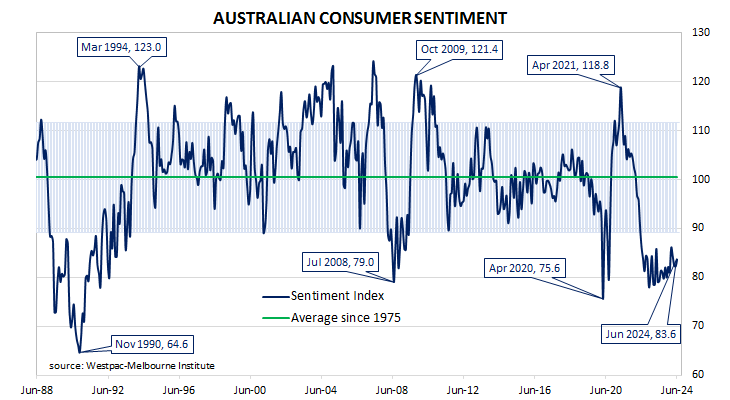Summary: Westpac-Melbourne Institute consumer sentiment index up in June; Westpac: fiscal support measures negated by increased concerns about inflation, outlook for interest rates; ACGB yields decline; rate-cut expectations firm; Westpac: sentiment deteriorated materially following June RBA decision; four of five sub-indices higher; more respondents expecting higher jobless rate.
After a lengthy divergence between measures of consumer sentiment and business confidence in Australia which began in 2014, confidence readings of the two sectors converged again in mid-July 2018. Both measures then deteriorated gradually in trend terms, with consumer confidence leading the way. Household sentiment fell off a cliff in April 2020 but, after a few months of to-ing and fro-ing, it then staged a full recovery. However, consumer sentiment then weakened considerably and has languished at pessimistic levels since mid-2022 while business sentiment has been more robust.
According to the latest Westpac-Melbourne Institute survey conducted over four days in the middle of June, household sentiment has improved, albeit to a level which is still quite pessimistic. Their Consumer Sentiment Index increased from May’s reading of 82.2 to 83.6, a reading which is significantly lower than the long-term average reading of just over 101 and well below the “normal” range.
“The survey detail suggests positives from fiscal support measures are being negated by increased concerns about inflation and the outlook for interest rates,” said Westpac senior economist Matthew Hassan.
Any reading of the Consumer Sentiment Index below 100 indicates the number of consumers who are pessimistic is greater than the number of consumers who are optimistic.
Commonwealth Government bond yields declined modestly along the curve on the day, generally lagging the overnight falls of US Treasury yields. By the close of business, 3-year and 19-year ACGB yields had both slipped 1bp to 3.89% and 4.21% respectively while the 20-year yield finished 2bps lower at 4.53%.
Expectations regarding rate cuts in the next twelve months firmed by the end of the day. In the cash futures market, contracts implied the cash rate would remain close to the current rate until at least the end of the year and average 4.32% through July, 4.35% in August and 4.335% in November. However, February 2025 contracts implied 4.255% while May 2025 contracts implied 4.12%, 20bps less than the current cash rate.
“Responses over the course of the survey week show sentiment deteriorated materially following the June RBA decision,” added Hassan. “The implication is that some consumer hopes of a more positive message on inflation and the interest rate outlook were again dashed.”
Four of the five sub-indices registered higher readings, with the “Family finances versus a year ago” sub-index posting the largest monthly percentage gain.
The Unemployment Expectations index, formerly a useful guide to RBA rate changes, increased from 129.8 to 133.1, a little higher than the long-term average. Higher readings result from more respondents expecting a higher unemployment rate in the year ahead.



